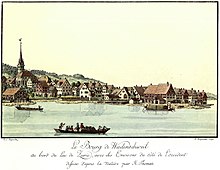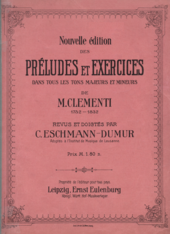Carl Eschmann-Dumur
Carl Eschmann-Dumur (* July 6, 1835 as Carl Eschmann in Wädenswil near Zurich ; † January 27, 1913 in Lausanne ) was a Swiss piano teacher .
Life
Carl Eschmann was born on July 6, 1835 in Wädenswil as the son of the conductor Rudolph Eschmann. He learned to play the piano with his nine years older cousin, the composer and conductor Johann Carl Eschmann . In adulthood he called himself Carl Eschmann-Dumur, "undoubtedly following the Swiss custom according to which a spouse takes his wife's surname and appends it to his own" - avoiding confusion with his cousin. Eschmann-Dumur succeeded his father as organist in Wädenswil; then he lived for a few years in Geneva and Lausanne; eventually he became a piano teacher at the Institut de musique de Lausanne . His nephew Rudolph Ganz was one of his students here and appeared pianistically for the first time during this time. In 1884 Eschmann-Dumur published the Guide du jeune pianiste, a guide to piano literature, and in 1887, the Exercices techniques pour piano, a collection of technical exercises. His achievements as a piano teacher were recognized beyond the country's borders. The great appreciation that Hans von Bülow showed him is documented - the latter wrote in a letter, "One person can advise me, Eschmann-Dumur, a piano-pedagogical phoenix". According to Hugo Riemann , Eschmann-Dumur was a "highly valued piano teacher". The 77-year-old died in Lausanne on January 27, 1913.

family
The ancestor of the Eschmann family of musicians, "probably the most impressive musical dynasty in Switzerland", was the musician and shoemaker Jakob Eschmann. Five sons took up music professions:
- Hans Jakob Eschmann (1786–1846), regimental bandmaster
- Heinrich Eschmann (1802–1882), military bandmaster in Winterthur , French horn player and bassoonist
- Rudolph Eschmann, Kapellmeister in Wädenswil
- a fourth son, apparently a clarinetist in the French army
- a fifth son, apparently a trumpeter in the French army
The piano teacher Barbara Eschmann (1816–1878), the violinist and Johann Kalliwoda student Jean Eschmann (1826–1869) and the pianist and piano teacher Henriette Eschmann (1829–1896) were children of Hans Jakob Eschmann. The composer and conductor Johann Carl Eschmann (1826–1882) was a son of Heinrich Eschmann, the piano teacher Carl Eschmann-Dumur discussed here was a son of Rudolph Eschmann. Marguitta Eschmann (1872–1944), a daughter of Johann Carl Eschmann, married a son of the composer Robert Radecke , the music researcher Ernst Radecke (1866–1920). Another generation later, two grandchildren of Barbara Eschmann made names for themselves in the music world: the pianist and composer Rudolph Ganz - pupil of Carl Eschmann-Dumur and Ferruccio Busoni - and the composer, writer and painter Hans Ganz .
The Guide du jeune pianiste contains the following memories of Carl Eschmann-Dumur's uncle Heinrich and his father Rudolph: “The extremely modest family circumstances offered them only limited opportunities; but they formed themselves in the best of all schools: those of the necessary, of work, and of initiative. Soon they could teach piano, violin, violoncello, double bass, all instruments. They played the organ in the church, conducted a choir, a small orchestra, a military music, they composed or arranged marches or hymns for the holidays, dances for the baptisms and celebrations. In so many places around you you took advantage of her talent. "
Publications
-
Guide du jeune pianiste. Classification méthodique et graduée d'œuvres diverses pour piano. Revised and enlarged 2nd edition. Ernest Rodolphe Spiess, Lausanne 1888.
The “Leader of the Young Pianist” divides etudes and pieces into 26 levels of difficulty. Level II includes e.g. B. the Etudes op. 100 by Friedrich Burgmüller , at level XXV the Etudes op. 25 by Frédéric Chopin . There are two further guides to piano literature from the Eschmann-Ganz family: As early as 1871, the cousin Johann Carl Eschmann published a very similar guide to piano literature (later continued by Adolf Ruthardt ); In 1969 the nephew Rudolph Ganz was supposed to publish a revised version of Ernest Hutcheson's Literature of the Piano . -
Exercices techniques pour piano in tous les tons majeurs et mineurs. Ernst Eulenburg , Leipzig 1887.
The "Technical Exercises for Piano in All Major and Minor Keys " have also been published in German and English by the same publisher: as Schule der Claviertechnik (translated by Adolf Ruthardt) and as Technical Pianoforte School in all major and minor keys (translated by Gustav Tyson-Wolff). With this work, Carl Eschmann-Dumur introduced key-symmetrical scale fingerings , which pianists like Moritz Moszkowski expressly took up. -
Nouvelle édition des Préludes et Exercices dans tous les tons majeurs et mineurs de M. Clementi. Ernst Eulenburg, Leipzig undated.
The «New edition of the preludes and exercises in all major and minor keys by Muzio Clementi », an appendix to his introduction to the art of playing the piano forte op. 42, «has above all the advantage that, as far as I know, it really brings something new by practically using the so-called symmetrical fingering of the scales, which is based on the symmetry of the keys and finger position ”, according to a contemporary review.
literature
- Hugo Riemann : Hugo Riemann's Music Lexicon. The 9th edition completely revised by the author and completed by Alfred Einstein. Max Hesses Verlag, Berlin 1919, entry "Eschmann".
- Chris Walton : Richard Wagner's Zurich. The Muse of Place. Camden House, Rochester / NY 2007, ISBN 978-1-57113-331-1 , therein pp. 132-134.
- Martin Widmaier: On the system dynamics of practice. Differential learning on the piano. Schott Music, Mainz 2016, ISBN 978-3-7957-0951-8 , therein the chapter “Carl Eschmann-Dumurs Exercices techniques ”, pp. 79-97.
Web links
- Literature by and about Carl Eschmann-Dumur in the catalog of the German National Library
- Carl Eschmann-Dumur in the Inventaires des Archives cantonales vaudoises (as of April 18, 2018).
- Carl Eschmann-Dumur on The Online Books Page (as of April 18, 2018).
Individual evidence
- ^ Hugo Riemanns Musik-Lexikon. Berlin 1919, entry "Eschmann" mentions February 3, 1913 as the date of death. But the current inventories of the Archives cantonales vaudoises bring January 27th.
- ↑ Chris Walton : Richard Wagner's Zurich. Rochester / NY 2007, p. 132. In the English original the quote is: "no doubt according to the Swiss custom whereby a husband adopts the surname of his wife, placing it after his own".
- ↑ Chris Walton: Richard Wagner's Zurich. Rochester / NY 2007, pp. 132/133.
- ^ James Francis Cooke: Great Pianists on Piano Playing. Godowsky, Hofmann, Lhévinne, Paderewski and 24 Other Legendary Performers. Reprint of the first edition 1917, Dover Publications, Mineola / NY 1999, ISBN 0-486-40845-0 , p. 310.
- ↑ Quoted according to Martin Widmaier: On the system dynamics of practicing. Mainz 2016, p. 79.
- ^ Hugo Riemanns Musik-Lexikon. Berlin 1919, entry "Eschmann".
- ↑ La vie musicale 1913, p. 251: "Il s'est endormi paisiblement." In this obituary, as in the Inventaires des Archives cantonales vaudoises , January 27 is given as the date of death.
- ↑ Chris Walton: Richard Wagner's Zurich. Rochester / NY 2007, p. 133. In the English original the quote is: “What must be Switzerland's most impressive music dynasty”.
- ↑ All information, including the missing names and dates, according to the family tree in Chris Walton: Richard Wagner's Zurich. Rochester / NY 2007, p. 134.
- ↑ The job title “music researcher” according to BMLO , entry “ Radecke, Ernst ” (as of April 18, 2018).
- ^ Carl Eschmann-Dumur: Guide du jeune pianiste , Lausanne 1888, p. 256. French original: "Les circonstances particulièrement modestes de leur famille leur offraient peu de ressources; mais ils se formères eux-mêmes à la meilleure des écoles: celle de la nécessité, du travail et de l'initiative propre. Bientôt ils furent en mesure d'enseigner le piano, le violon, le violoncelle, la contrebasse, tous les instruments. Ils jouaient l'orgue à l'église, dirigeaient un chœur, un petit orchester, une musique militaire; ils composaient ou arrangeait des marches ou des hymnes pour les jours solennels, des danses pour les baptêmes et les fêtes. De plusieurs lieues à la ronde, on avait recours à leur talent. ».
- ↑ Chris Walton: Richard Wagner's Zurich. Rochester / NY 2007, p. 133.
- ↑ Martin Widmaier: On the system dynamics of practice. Mainz 2016, p. 86.
- ^ Journal of the International Music Society. 1903/1904, p. 338.
| personal data | |
|---|---|
| SURNAME | Eschmann-Dumur, Carl |
| ALTERNATIVE NAMES | Eschmann, Carl (maiden name) |
| BRIEF DESCRIPTION | Swiss piano teacher |
| DATE OF BIRTH | July 6, 1835 |
| PLACE OF BIRTH | Waedenswil |
| DATE OF DEATH | January 27, 1913 |
| Place of death | Lausanne |
